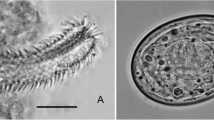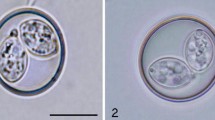Abstract
Spores ofMyxobolus cotti El-Matbouli and Hoffmann 1987 andM. cerebralis Hofer 1903 (fresh or after 5 months in mud) are taken in by tubifex worms and develop in their gut epithelium cells into actinosporea of the genusTriactinomyxon. Triactinomyxon deriving fromM. cotti differ distinctly from those derived fromM. cerebralis in morphology and the number of sporozoites in the epispore. It could be shown thatTriactinomyxon spores infect fish either via the water (bullhead, rainbow trout) or by feeding of infected tubifex (rainbow trout), developing intoMyxobolus spores in central nervous tissue (bullhead) or cartilage (rainbow trout). Fresh or ripened spores ofM. cotti andM. cerebralis were not infectious for bullheads or rainbow trout, respectively. The results of our experiments confirm the hypothesis that the life cycle ofM. cotti andM. cerebralis includes an intermediate host and a metamorphosis into actinosporea of the genusTriactinomyxon.
Similar content being viewed by others
References
El-Matbouli M, Hoffmann R (1987) Eine neue Myxobolus-Art (Myxozoa; Myxobolidae) im Zentralnervensystem der Koppe (Cottus gobio). Verh Dtsch Zool Ges 80:191
Hamilton AJ, Canning EU (1987) Studies on the proposed role ofTubifex tubifex (Muller) as an intermediate host in the life cycle ofMyxosoma cerebralis Hofer, 1903. J Fish Dis 10:145–151
Hoffman G (1962) Whirling disease of trout. U.S. Department of the Interior. Fishery Leaflet 508:1–3
Levine ND, Corliss JO, Cox FEG, Deroux G, Grain J, Honigberg BM, Leedale GF, Loeblich AR, Lóm J, Lynn D, Merinfeld EG, Page FC, Polyansky G, Sprague N, Navra J, Wallace FG (1980) A newly revised classification of the Protozoa. J Protozool 27:37–58
Markiw ME, Wolf K (1983)Myxosoma cerebralis (Myxozoa, Myxosporea) etiologic agent of salmonid whirling disease requires tubificid worms (Annelida: Oligochaeta) in its life cycle. J Protozool 30:561–564
Wolf K, Markiw HE (1984) Biology contravenes taxonomy in the Myxozoa: new discoveries show alternation of invertebrate and vertebrate hosts. Science 225:1449–1452
Wolf K, Markiw ME, Hiltunen JK (1986) Salmonid whirling disease:Tubifex tubifex (Muller) identified as the essential oligochaete in the protozoan life cycle. J Fish Dis 9:83–85
Author information
Authors and Affiliations
Rights and permissions
About this article
Cite this article
El-Matbouli, M., Hoffmann, R. Experimental transmission of twoMyxobolus spp. developing bisporogeny via tubificid worms. Parasitol Res 75, 461–464 (1989). https://doi.org/10.1007/BF00930973
Accepted:
Issue Date:
DOI: https://doi.org/10.1007/BF00930973




